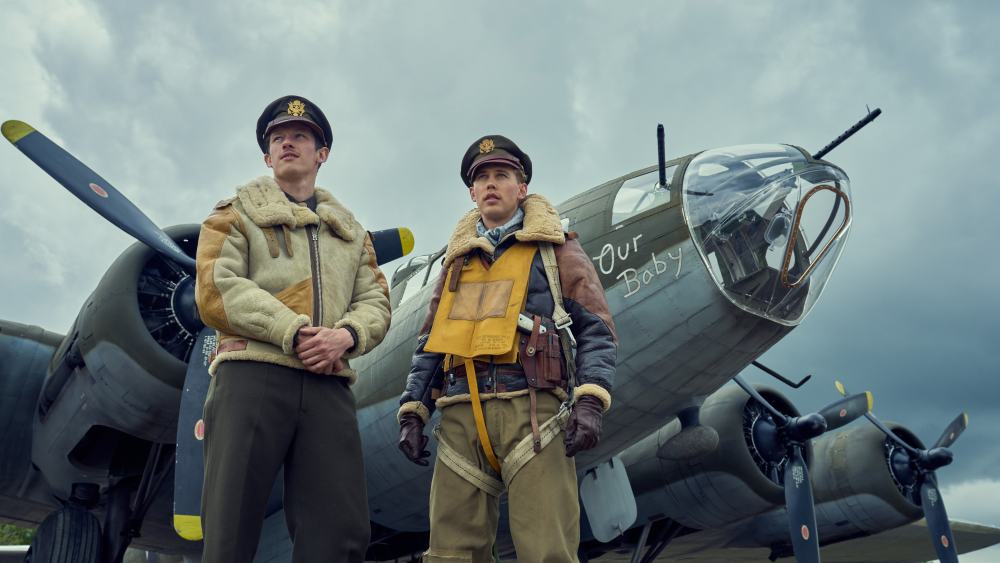In the final chapter of Apple TV+‘s “Masters of the Air,” a despondent Holocaust survivor reflects on burying every member of his family. He says, “To live, one must make choices.” The circumstances of war and survival make these decisions more complex and heart-wrenching. Based on the authoritative account by World War II historian Donald L. Miller, “Masters of the Air” is a blistering war drama told from the perspective of the men of the 100th Bomb Group aptly nicknamed the “Bloody Hundredth.” A vast narrative — one that could have quickly fallen into a catalog of typical war series tropes — blossoms, becoming a fascinating chronicle of courage, loss and the ravaging of humanity.
Created by John Shiban and John Orloff, with executive producers Steven Spielberg, Tom Hanks and Gary Goetzman, the series largely reunites the team behind HBO’s 2002 Emmy-winning war drama, “Band of Brothers.” The show opens in the spring of 1943. Best friends, Maj. Gale “Buck” Cleven (Austin Butler) and Maj. John “Bucky” Egan (Callum Turner) prepare to ship out to the Bluie West One Airfield in South Greenland. (The similar nickname is a quippy, well-explained inside joke between the pair.) Calm, reserved and even-tempered, Buck doesn’t drink, dance or gamble.
In contrast, Bucky, a hot-headed wildcard who gets to Greenland weeks before his friend, is ready for action. Still, when he arrives and embarks on his inaugural mission as a pilot in one of the huge bomber planes, he encounters more death, blood and brutality than he could have imagined. Upon landing, the typically jovial Bucky is stunned to silence.
The initial three episodes of the series — which, according to Puck, cost Apple a total of $300 million — are almost too vast. Aside from Buck, Bucky and Barry Keoghan‘s Lt. Curtis Biddick, the viewers scramble to place names to faces. Moreover, the countless missions and horrific loss of life that the “Bloody Hundredth” experience is disorienting, like being trapped in a brutal video game. The endless air combat amounts to blown-off faces, bodies tumbling through the sky, and obliterated airbuses. The overwhelming action in the first three hours makes the show’s opening chapters too dense. Only the astonishing cinematography, especially during the ariel battles and narration by bomber navigator Maj. Harry Crosby (Anthony Boyle) keeps the series buoyant. However, in Part Four, “Masters of the Air” truly finds its stride.
The fourth episode opens in the Fall of 1943. With only 12 out of the 35 “Bloody Hundredth” crews remaining, the number of casualties is cataclysmic. While most of the men (as many as 150 in one afternoon) have perished, others are stuck behind enemy lines, having bailed out of their crashing planes by parachute. This chapter puts the viewer back on the ground and showcases Sgt. William Quinn (Kai Alexander) and Lt. Ron Bailey (Ian Dunnett Jr.) embark on a perilous journey full of panic and uncertainty as they try to return to base.
Often, in TV shows and films depicting the Second World War, there are few, if any, frank examinations of the soldiers’ mental health and the toll these unimaginable circumstances take. Yet, “Masters of the Air” places the emotional and psychological aspects of the war front and center, including screaming, descriptions of smells and, of course, the visuals. From the men who die some 25,000 feet in the air to the POWs who trudge, nearly frozen to death, across Germany, it is all nearly unimaginable to witness. When Crosby is promoted to group navigator, booting him off the aircraft and into the office, every life lost feels like a personal failure. Likewise, Maj. Robert “Rosie” Rosenthal (Nate Mann), a pilot, struggles immensely with survivor’s guilt, especially after the Air Force ups the required missions from 25 to 30 for a completed deployment. Most men don’t make it past their 11th assignment.
Still, the most intriguing aspects of “Masters of the Air” occur in the last three episodes. In Part Seven, which depicts the aftermath of March 6, 1944, aka Black Monday, when more men and planes were lost than any other day during the war, the Air Force is at long last forced to reconsider their strategy and deep-seated racism or face losing the war. Episode 8 introduces the Tuskegee Airmen, aka The Red Tails, 2nd Lt. Alexander Jefferson (Branden Cook), 2nd Lt. Robert Daniels (Ncuti Gatwa) and 2nd Lt. Richard Macon (Joshian Cross). Despite being under-ranked, underpaid and underutilized, these impeccably trained Black airmen piloted the fast and efficient single-seater P-51 aircrafts that would eventually guard the bombers, curtailing deaths by leaps and bounds.
As “Masters of the Air” flows toward the culminating days of the war, the remaining men are presented in a new light. After all, even if you survive the battles, extreme conflict will shift and harden the spirit, morphing you into someone you may not recognize. Depictions of the bleeding, burnt, scalped, and starving remain throughout, but as the show reiterates, this is what the men who brought the war to Hitler’s doorstep endured. The series is massive, beautifully rendered and a reminder that war is murderous, gruesome and horrifically human.
The first two episodes of “Masters of the Air” premiere Jan. 26 on Apple TV+ with new episodes dropping weekly on Fridays.

